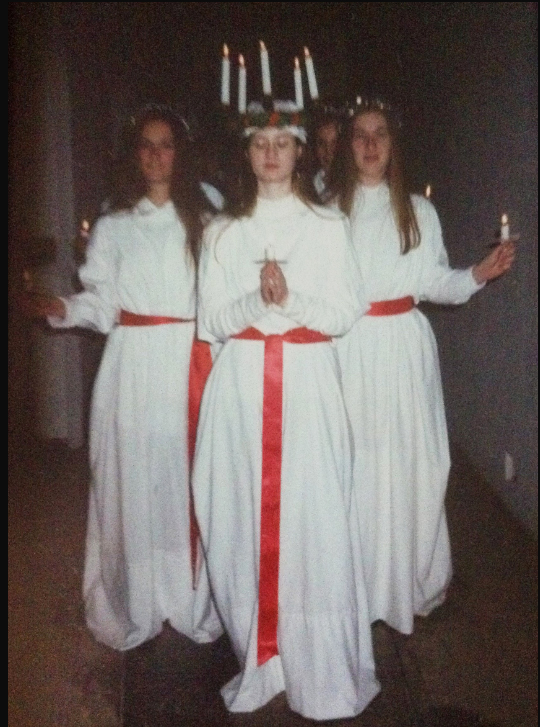In many Nordic countries, the 13th of December starts with candlelight in darkness, songs and saffron buns. It is Saint Lucy’s or Lucia’s day: a somewhat unlikely but popular tradition observed widely in Sweden, Norway, Finland and Denmark, and to a lesser degree in Iceland.
Saint Lucy is a Catholic saint who died in the 4th century: she is considered a Christian martyr and her feast day is celebrated elsewhere, too – the Nordic celebration has little to do with current Catholic traditions.
While most Nordic Christmas customs are in keeping with Protestant traditions, Saint Lucia’s – as the saint is known in Nordic countries – day is a popular celebration. The traditions observed today can be traced back to 18th century Sweden, but the present-day form of the celebration originated in Sweden and Norway in the first half of the 20th century, replacing the Lussinatt/Lussenatt tradition which marked the longest night of the year. It was thought that gnomes, trolls and spirits roamed the earth from that night until Christmas.
Today, the Nordic Lucia tradition centres around a procession of women clad in white gowns and red sashes, each holding a candle. The procession is led by a girl representing Lucia. The “Lucia” also wears a crown of candles on her head, often real, but sometimes electric.
So, what do the candles and the name Lucia actually signify in this celebration? Etymologically, Lucia derives from the Latin word lux, meaning light. Although not a concrete explanation, this is perhaps the clearest connection between the saint and the celebrations by candlelight today.
The candle-lit procession is led by Lucia into the darkened room where the audience is sitting, which represents Saint Lucia bringing light during the darkest time of the year. This procession is accompanied by the singing of local lyrics to the tune of the Italian song Santa Lucia. The lyrics vary by country but they tend to focus on light overcoming darkness.
In some places, men also take part in the proceedings. The stjärngossar or “star boys” will follow the female procession, sometimes dressed in a white robe and conical hat adorned with stars, or sometimes dressing as Christmas elves.
At STP, many of our staff have personal memories of Lucia celebrations – there was even a surprise procession in our Whiteley office a few years ago, complete with saffron buns (lussekatter) and singing.
Danielle Davis, Nordic-English Lead Translator
The photo is from 1996 when I was a first year Swedish student at the University of Wales, Lampeter. When they still taught Swedish at Lampeter, they held a Lucia service each year in the chapel. The procession was mostly students of Swedish and exchange students.
is from 1996 when I was a first year Swedish student at the University of Wales, Lampeter. When they still taught Swedish at Lampeter, they held a Lucia service each year in the chapel. The procession was mostly students of Swedish and exchange students.
After only doing Swedish for a couple of months we didn’t really know what we were singing but it was enjoyable! We made our outfits from college bedsheets (so no cutting!) and the crown was really heavy so I did have a bad headache the next day.

Didde Gaardsted, Danish Translator

I remember doing the Lucia procession as a child at the local nursing home with the rest of my classmates. It was a tradition to do this every year and of course the kids all loved it, primarily because it involved getting time off from regular classes and eating biscuits after the procession!
Alas, I was always the bridesmaid, never the (Lucia) bride. I walked in the middle of the procession in my white dress – doing my best to make sure my candle didn’t blow out!
Ida Berntzen, Norwegian Account Linguist
We had a procession  each year when I was at school. We had a rota, so that as many people as possible got to be Lucia. I was Lucia once, too! I remember finding the crown of candles scary, though I’m not sure if the candles were actually real or electric.
each year when I was at school. We had a rota, so that as many people as possible got to be Lucia. I was Lucia once, too! I remember finding the crown of candles scary, though I’m not sure if the candles were actually real or electric.
On Lucia’s day, it’s a must to eat lussekatter! We bake the saffron buns before the 13th and eat them on the day itself.
Camilla Arnoldsson Whitlock, Translation Team Manager
My home town  newspaper used to have a “beauty contest” where you could vote among 10–15 teenage girls to be the town’s Lucia each year. The one with the most votes won the honour of being Lucia and the rest were her “bridesmaids”. They had to sing in procession in various places on the 13th and probably during the week surrounding Lucia, such as the town square, old people’s homes, large corporate events and the main church in town.
newspaper used to have a “beauty contest” where you could vote among 10–15 teenage girls to be the town’s Lucia each year. The one with the most votes won the honour of being Lucia and the rest were her “bridesmaids”. They had to sing in procession in various places on the 13th and probably during the week surrounding Lucia, such as the town square, old people’s homes, large corporate events and the main church in town.
Nelly Nilsson, Swedish Translator
When I was at school, there would be a procession in the morning, and it was always the students in year 8 that were in charge of it – I guess they were deemed old enough not to set each other on fire! The rest of the students would all gather in the gym which would have been made ready with mats and other cosy stuff to sit on, all the lights would be turned off so it was pitch black and then the procession would walk in. Afterwards, we would naturally all have lussekatter and pepparkakor (gingerbread)!
there would be a procession in the morning, and it was always the students in year 8 that were in charge of it – I guess they were deemed old enough not to set each other on fire! The rest of the students would all gather in the gym which would have been made ready with mats and other cosy stuff to sit on, all the lights would be turned off so it was pitch black and then the procession would walk in. Afterwards, we would naturally all have lussekatter and pepparkakor (gingerbread)!
I was also part of a children’s church choir when I was around 8–12 years old, so in the evening after school we would usually do processions in three places: an old people’s home, a local manor and finally the church. All in all, it was a pretty intense day, but it was always something I looked forward to a lot. These days I mostly just get up early to watch the Lucia concert on SVT1 and eat lussekatter and pepparkakor any chance I get!
Camilla Åsberg, Swedish Account Linguist
A trick that is both very important and not always remembered when you are a tärna (bridesmaid) in the Lucia procession is to hold the burning candle in your hand slightly to the side, as the flame consumes the oxygen right above it. The kids sometimes hold the candle directly under their face, which often results in them fainting as the flame limits their oxygen.
I remember one disastrous Lucia procession I was part of when I was 11. There was the terrible sound of loud thuds echoing through the room each time another tärna went down. Our teacher, who had a strong “the show must go on” mentality, was standing in a corner gesturing at the rest of us to carry on singing. In the middle of all this, a girl fainted and as she fell, she waved her candle and accidentally set another girl’s hair on fire. Chaos broke out and that was the end of that performance!
They managed to put out the fire quickly, and despite the memories of that “burnt hair” smell even now, I still love the Lucia celebrations: watching the bigger Lucia processions and choirs, lighting candles, drinking glögg and having all the lussekatter I can eat!
Icebreaker, Icebreaker December 2018, Nordic culture, Nordic focus



